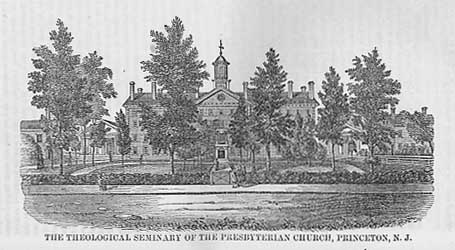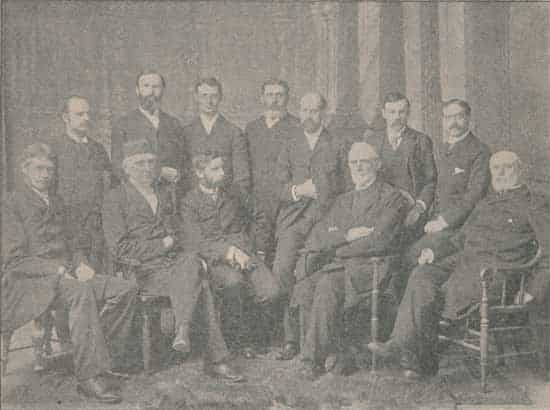Ideas & Actions Have Consequences
On this day, August 15th, in 1861, a group of pastors and ruling elders met in Atlanta to plan the division of a new denomination, splitting off from the Old School wing of the Presbyterian Church in the United States of America. Strictly speaking, the Southern Old School men did not divide over the matter of slavery. Rather, their point of division was the Gardiner Spring Resolutions. What follows is an account of how that division came about, written by the Rev. Moses D. Hoge, and found as chapter 22 in the volume, Presbyterians: A Popular Narrative… (1892):—
In May, 1861, the General Assembly of the Presbyterian Church in the United States of America (Old School), which met in Philadelphia, adopted a paper in reference to the Civil War, which begun the month before. This paper became known as the Spring Resolutions, after the Rev. Gardiner Spring, pastor of the Brick Church in New York and the minister who brought these resolutions to the floor of that General Assembly. Three times these resolutions were put before the Assembly, and twice they failed of vote, but with some changes, passed on the third presentation. With the adoption of the Spring Resolutions, the Assembly undertook to decide for its whole constituency, North and South, a question upon which the most eminent statesmen had been divided in opinion from the time of the formation of the Constitution, namely, whether the ultimate sovereignty, the jus summi imperii, resided in the people as a mass, or in the people as they were originally formed into colonies and afterward into States.
Presbyterians in the South believed that this deliverance, whether true or otherwise, was one which the Church was not authorized to make, and that, in so doing, she had transcended her sphere and usurped the duties of the state. Their views upon this subject found expression in a quarter which relieves them of all suspicion of coming from an interested party. A protest against this action was presented by the venerable Charles Hodge, D.D., of Princeton Theological Seminary, and fifty-seven others who were members of that Assembly.
In this protest it was asserted, “that the paper adopted by the Assembly does decide the political question just stated, in our judgment, is undeniable. It not only asserts the loyalty of this body to the Constitution and the Union, but it promises in the name of all the churches and ministers whom it represents, to do all that in them lies to strengthen, uphold and encourage the Federal Government. It is, however, a notorious fact that many of our ministers and members conscientiously believe that the allegiance of the citizens of this country is primarily due to the States to which they respectively belong, and that, therefore, whenever any State renounces its connection with the United States, and its allegiance to the Constitution, the citizens of that State are bound by the laws of God to continue loyal to their State, and obedient to its laws. The paper adopted virtually declares, on the other hand, that the allegiance of the citizen is due to the United States, anything in the Constitution or laws of the several States to the contrary notwithstanding. The General Assembly in thus deciding a political question, and in making that decision practically a condition of Church membership, has, in our judgment, violated the Constitution of the Church, and usurped the prerogative of its Divine Master.”
Presbyterians in the South, coinciding in this view of the case, concluded that a separation from the General Assembly aforesaid was imperatively demanded, not in the spirit of schism, but for the sake of peace, and for the protection of the liberty with which Christ had made them free.
After the adoption of the Gardiner Spring Resolutions in May of 1861, Presbytery after Presbytery in the Southern States, feeling that by that act they had been exscinded, withdrew from the jurisdiction of the Assembly that had transcended its sphere and decided political questions. A conference of ministers and elders was held in Atlanta on August 15-17, 1861, and in response to a call thus issued the Assembly met.
Accordingly, ninety-three ministers and ruling elders, representing forty-seven Presbyteries, duly commissioned for that purpose, met in the city of Augusta, Georgia, on the 4th of December, 1861, and integrated in one body. The first act after the organization of that memorable Assembly was to designate a name for the now separated Church, and to declare its form and belief.
Something to Ponder:
The North/South division of the Old School Presbyterians did not happen in an historical vacuum. That brief comment above, “…feeling that by that act they had been exscinded,…” is an intriguing key. Could it be that the division of 1861 happened in part because of the division of 1837? In the division of 1837, the Old School Presbyterians unwittingly established a precedent when they exscinded four Synods which were predominantly New School. In making this observation, I am not arguing that they were right or wrong, but simply that ideas and actions have consequences. The overt exclusion of four Synods in 1837 was still a recent memory in 1861, and in that light it seems a more reasonable suspicion that now it was the Southern churches which were being excluded, whether overtly or not.
Our actions have consequences. Once you do something, it becomes easier to repeat that action. This is how habits are formed. This is how we learn. And this can be either good or bad. On the positive side of things, skills and abilities can be tuned to a fine pitch; all manner of tasks can be mastered. But, by allowing a first transgression, we can also become quite adept at sin. Instead, let us fear God and hate evil. Like Joseph, turn from sin at its first appearance, and run! Or, to return to our story, imagine how things might have turned out, had that first slave ship been refused access to our shores? What sort of nation would we be if a different precedent had been set from the start? We can’t undo history, but we can find forgiveness and mercy in Christ as our Lord and Savior.
[excerpted from Presbyterians: A Popular Narrative of their Origin, Progress, Doctrines, and Achievements, by Rev. Geo. P. Hays, D.D., LL.D. New York: J. A. Hill & Co., Publishers, 1892, pp. 483-486.]
 Educated at the College of New Jersey (Princeton University), and graduating there in 1876. he then worked as a teacher while preparing for the ministry at Princeton Theological Seminary, 1877-1880. Rev. Greene was ordained by the Presbytery of Boston (PCUSA) on 3 June 1880 and installed as pastor of the First Presbyterian church of Boston, where he served from 1880-1883. He next answered a call to serve as senior pastor of the Tenth Presbyterian church, in Philadelphia, succeeding Dr. John DeWitt in that post and serving there from 1883-1892. Finally, he was then appointed to serve as the Stuart Professor of the Relations of Philosophy and Science to the Christian Religion, at the Princeton Theological Seminary, a post he held until 1903, after which he held the Chair of Apologetics and Christian Ethics, from 1903 until his death in 1928. Among his many honors, he was awarded the Doctor of Divinity degree by the College of New Jersey in 1891.
Educated at the College of New Jersey (Princeton University), and graduating there in 1876. he then worked as a teacher while preparing for the ministry at Princeton Theological Seminary, 1877-1880. Rev. Greene was ordained by the Presbytery of Boston (PCUSA) on 3 June 1880 and installed as pastor of the First Presbyterian church of Boston, where he served from 1880-1883. He next answered a call to serve as senior pastor of the Tenth Presbyterian church, in Philadelphia, succeeding Dr. John DeWitt in that post and serving there from 1883-1892. Finally, he was then appointed to serve as the Stuart Professor of the Relations of Philosophy and Science to the Christian Religion, at the Princeton Theological Seminary, a post he held until 1903, after which he held the Chair of Apologetics and Christian Ethics, from 1903 until his death in 1928. Among his many honors, he was awarded the Doctor of Divinity degree by the College of New Jersey in 1891.



